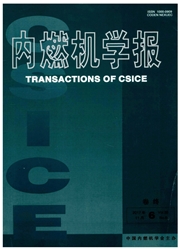

 中文摘要:
中文摘要:
为探究柴油/松油混合燃料的喷雾特性,基于高压可视化容弹试验台,通过高速摄影技术对掺松油的柴油混合燃料的喷雾过程进行试验研究,分析了喷射压力、背压和燃料物性的改变对喷雾宏观参数的影响。结果表明:混合燃料的喷雾贯穿距离先呈现一定程度的线性增长,然后增长幅度逐渐变小,喷雾锥角呈先减小再保持在一个相对稳定的数值趋势,但全程锥角变化不大;喷射压力从90 MPa升高至150 MPa,混合燃料的喷雾锥角和贯穿距离的平均增幅分别为9.2%和15%;背压从3 MPa增加到5 MPa,混合燃料的平均喷雾锥角增幅约2.6°,而贯穿距离降低11 mm左右,说明背压的改变对喷雾特性影响显著;将广安公式适当地修正可与混合燃料的贯穿距离相互吻合;向柴油中掺混一定比例的松油后,燃料的黏度降低,会引起喷雾锥角、贯穿距离和油束面积均小幅增大,增强燃料的油气混合。试验研究有助于改善柴油的雾化质量,可为柴油机代用燃料的筛选提供参考。
 英文摘要:
英文摘要:
The fuel spray performance and atomization quality played a fundamental role in promoting the level of combustion efficiency and exhaust emissions in internal combustion engines. In order to achieve better atomizing mode of diesel, we conducted experiments to study the spray characteristics of diesel blending pine oil. A diesel/pine oil spray trial platform was constructed to carry out a visual constant volume chamber and the high-pressure common rail test bench. The high-speed photograph technique was applied to systematically investigate the spray process of blended fuel. The study was conducted under the pine oil blending ratios of with 0, 20%, 40% and 50%, respectively. Then, the influences of injection pressure, ambient pressure and fuel property on macroscopic spray parameters(including spray cone angle, spray penetration distance and fuel flow area) were investigated. The results showed that at first, the spray penetration distance of blended fuel presented a certain degree of linear growth with the fuel injection, and then the increasing rate of the penetration distance decreased. On the other hand, it was observed that the spray cone angle was wider at the beginning of the spray development, and it gradually converged to a smaller and constant value. In general, the variation of the spray cone angle is stabilized during spray process. For the same ambient pressure(5 MPa), the blended fuel had a longer penetration distance with increasing the fuel injection pressure from 90 MPa to 150 MPa. And the effect of injection pressure on the spray cone angle according to the variation in injection pressure showed that the spray cone angle at a 150 MPa injection pressure was larger than that at 90 MPa of injection pressure. The percentage increased in the mean spray cone angle and penetration distance was 9.2% and 15%, respectively. When the ambient pressure increased from 3 MPa to 5 MPa at the same injection pressure(12 MPa), the increment of ambient pressure led to obvious increase of the spray cone a
 同期刊论文项目
同期刊论文项目
 同项目期刊论文
同项目期刊论文
 期刊信息
期刊信息
